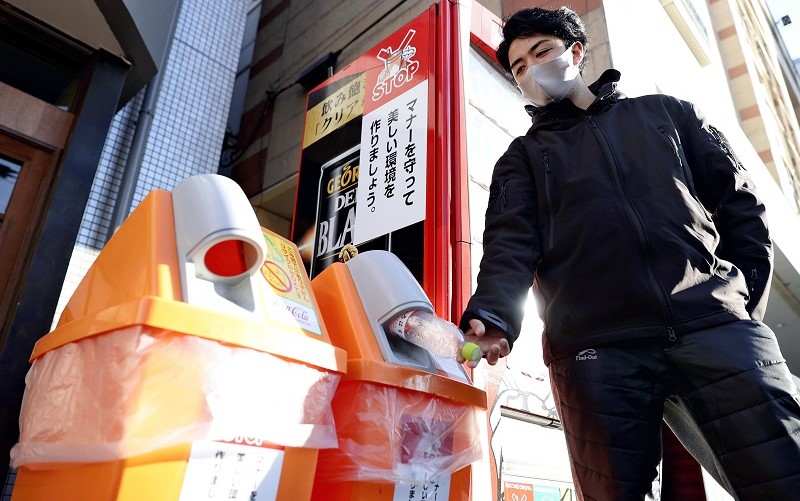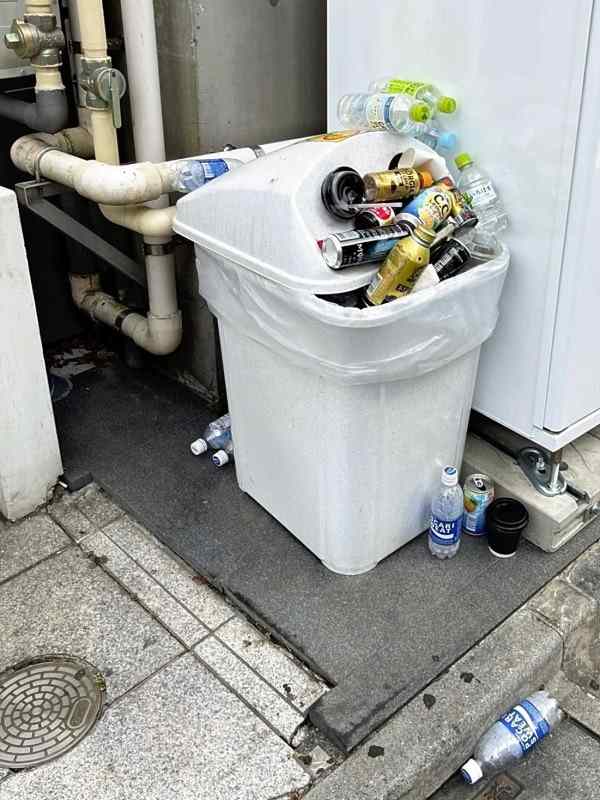
A man puts an empty plastic bottle into a new type of recycling bin in Chofu, Tokyo, on Dec. 16.
7:00 JST, January 12, 2023
Vending machine and beverage manufacturing organizations have come up with a peculiar plastic bottle recycling bin. The receptacle’s opening points downward as part of efforts to prevent people from tossing other waste into the bin.
The idea is now attracting attention for promoting PET bottle recycling.

A conventional recycling bin that is overflowing with plastic bottles and empty cans
According to the Council for PET Bottle Recycling, since the recycling of plastic bottles became mandatory in 1997, vending machine installers began to set up recycling bins beside the machines to collect empty containers. However, different types of trash, such as cigarette butts, plastic bags, lighters and batteries, have often been tossed into the bins. In recent years, this tendency has become more noticeable.
A 2018 survey of recycling bins in Tokyo by the Japan Soft Drink Association found that about 30% of the bins’ contents was other trash.
The increase in the rate of other trash stems from the removal of wastebaskets from public places.
Many convenience stores nationwide started to move outdoor wastebaskets inside their stores to prevent people from throwing household trash into them. Railroad stations have removed garbage cans as part of anti-terrorism measures.
A survey said the rate of trash other than plastic bottles in such bins rose about 10% after garbage cans were removed at stations, according to the Japan Automatic Merchandising Association.
Smaller opening
After being collected, plastic bottles are crushed into small pieces and then recycled into various items such as carpets and other interior furnishings, stationery and clothing.
If the recycling bin contains a lot of other waste, it is costly to separate the garbage. In addition, if plastic bottles become contaminated by food and other waste, they cannot be recycled for some time.
Yuichi Morohashi, executive officer of Kinoshita Friend, a recycling company in Tokorozawa, Saitama Prefecture, said: “Recycling bins fill up quickly if more of other types of waste gets mixed in. Sorting out such waste in order to collect plastic bottles requires a lot of time.”
The Japan Soft Drink Association and Japan Automatic Merchandising Association began developing the new type of recycling bin in 2020.
The downward-facing opening makes it difficult for people to toss in trash, and the diameter is small enough to prevent anything larger than plastic bottles and cans from being deposited.
By introducing the new recycling bins on a trial basis from 2020 to 2021 in Shibuya Ward, Tokyo; Hamamatsu; Tsu; Hiroshima and other locations, the rate of other waste was reduced by between 30% and 50%.
In an online survey conducted in April last year, nearly 40% of 1,000 respondents said they “did not know” that a recycling bin was exclusively for collecting beverage containers. Accordingly, a sticker was posted beside the slot stating in large letters: “This is not a garbage can. This is a recycling bin.”
In addition, the color of the bin was changed to bright orange so that it will not be mistaken for a garbage can.
Many orders
When the new type of recycling bin went on sale in mid-October, the manufacturer received orders for more than 10,000 units.
“If garbage other than plastic bottles increases, the original purpose behind recycling will be lost. We hope to change consumer awareness by promoting the new recycling bins,” said Kunitoshi Iuchi, executive director of the association.
The government is also paying attention to the new type of recycling bin.
In late October, the Environment Ministry installed about 300 of the new bins near train stations in Chofu, Tokyo, and Kawasaki to examine whether the amount of garbage thrown into the bins can be reduced.
The ministry plans to encourage wider use of the new bins if it confirms their effectiveness.
According to the Council for PET Bottle Recycling, 23.4 billion plastic bottles for soft drinks were shipped in fiscal 2021.
The recycling rate of plastic bottles in Japan has been hovering around 85% for the past 10 years, maintaining a high level compared to Europe at about 40% and the United States at about 20%.
"Science & Nature" POPULAR ARTICLE
-

Genome Study Reveals Milestone in History of Cat Domestication
-

Big Leap in Quest to Get to Bottom of Climate Ice Mystery
-

Security Camera Footage Vulnerable to Outside Access; Investigation Finds 3,000 Pieces Exposed Online
-

Japan Set to Participate in EU’s R&D Framework, Aims to Boost Cooperation in Tech, Energy
-

Paws on Parade: Nairobi’s Dogs Dazzle at ‘Pawchella’
JN ACCESS RANKING
-

Tokyo Economic Security Forum to Hold Inaugural Meeting Amid Tense Global Environment
-

Keidanren Chairman Yoshinobu Tsutsui Visits Kashiwazaki-Kariwa Nuclear Power Plant; Inspects New Emergency Safety System
-

Imports of Rare Earths from China Facing Delays, May Be Caused by Deterioration of Japan-China Relations
-

University of Tokyo Professor Discusses Japanese Economic Security in Interview Ahead of Forum
-

Japan Pulls out of Vietnam Nuclear Project, Complicating Hanoi’s Power Plans


























